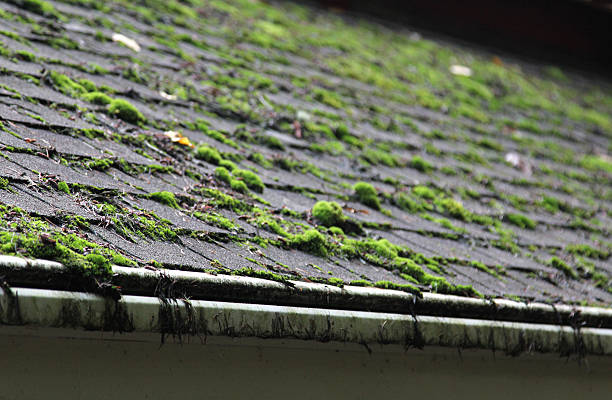Protect our creeks, ponds, and shorelines by choosing water‑safe ways to control moss on your roof.
Many moss control products contain bleach, ammonia, or other toxic chemicals that harm fish, amphibians, and water quality when washed into storm drains or directly into creeks. What goes on your roof can end up in the water!
Why Be Careful?
- Common moss killers (e.g., bleach‑based sprays like “30 Seconds”) are toxic to aquatic life even at low levels.
- Runoff from roofs enters storm drains or soaks into nearby creeks and ponds.
- Small changes at home help keep our watershed healthy.

Remove moss manually
- On a dry day, sweep moss gently off shingles with a stiff broom or plastic roof rake.
- Collect moss and dispose of it in yard waste—don’t rinse into drains or the creek.
Choose water‑safe products
- Look for moss control products that are eco-certified and made from potassium salts (Safer Moss & Algae Killer and Surface Cleaner, Scotts EcoSense Moss Control) or use less toxic home remedies like baking soda (sprinkled directly on moss) or horticulture vinegar (10-20% acetic acid, use sparingly).
- Avoid products containing bleach, ammonia, or "quick-kill" sprays labelled as corrosive or harmful to aquatic life.
- Follow label directions and avoid over‑application.
- Temporarily redirect downspout flow to drain water across grass or vegetation to filter out contaminants.
Prevent moss from returning
- Install zinc or copper strips along your roof ridge—rainwater will carry trace amounts down the roof and inhibit moss regrowth.
- Keep trees trimmed back to reduce shade and moisture on your roof.
- Inspect your roof every 6-12 months and treat early before moss gets thick.
Every little bit helps!
By choosing water‑safe methods, you help protect our local creeks, ponds, and the wildlife that depends on them. For more tips on protecting water quality at home, visit: www.crd.bc.ca/watersheds.


Great advice! Roofs near water need extra care—these best practices for moss control and water protection are essential for long-term durability.
Great advice for roofs near watercourses! Controlling moss growth and protecting against moisture is key. Regular cleaning, using moss inhibitors, and ensuring proper drainage help prevent damage. Proper maintenance keeps your roof strong and water-resistant in these sensitive areas.